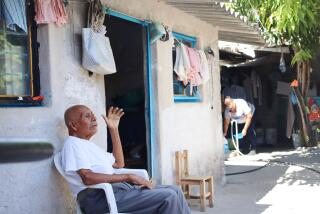L.A. clinic is 1st in U.S. to treat Chagas
A Los Angeles County hospital has opened the first clinic in the country devoted to studying and treating Chagas disease, a deadly parasitic illness that has long been the leading cause of heart failure in Latin America and is now being seen in immigrant communities in the United States.
Unless Chagas is treated early, little can be done to halt its advance. Yet because 10 to 20 years can pass before heart or gastrointestinal complications develop, many people don’t realize they’re infected with what has been called a silent killer.
“We really, really need to become more aware of the potential of this disease in our Latin American population because the long-term outcome is pretty horrific,” said Dr. Sheba Meymandi, director of the new center at Olive View-UCLA Medical Center in Sylmar. “If we can block the progression to full-blown Chagas disease and heart failure, we’d be doing a huge service.”
Like Lyme disease or malaria, Chagas is a vector-borne illness, meaning that it is transmitted by insects, not person-to-person contact. For Chagas, the insect is a winged, blood-sucking creature commonly called a conenose, or kissing bug, because it feeds at night, often on uncovered faces.
An estimated 8 million to 11 million people in Central and South America and Mexico are infected, according to the U.S. Centers for Disease Control and Prevention. Chagas is most common in poor, rural areas, where adobe houses with cracked walls, thatched roofs or dirt floors allow the bugs easy entry.
The parasitic illness can also pass from mother to child at birth and through blood or organ transfusions, which have become the main source of infection in Latin American cities. In December, the U.S. Food and Drug Administration approved a test for screening the blood supply by testing for antibodies to the parasite. The American Red Cross and Phoenix-based Blood Systems, which collect about 65% of the U.S. blood supply, have been using the test since January.
By the end of October, 253 people in 30 states had tested positive for the antibody, according to data compiled by the American Assn. of Blood Banks. The prevalence nationwide is estimated to be about 1 in 30,000 donors, and about 1 in 7,000 in Los Angeles, said Dr. Susan Stramer, executive scientific officer for the American Red Cross.
“We’ve been suspecting that the number was going to be large, but finding that it is large is still surprising,” said Dr. James H. Maquire, former chief of the parasitic diseases branch at the CDC and now director of international health at the University of Maryland School of Medicine. “Screening the blood supply was the absolutely right thing to do.”
Before the test was developed, the CDC knew of 10 people in the U.S. who were infected from transfusions or organ transplants, including two heart transplant recipients in Los Angeles. The two transplant patients later died, though not directly from Chagas, the CDC said.
Most donors who tested positive since screening began this year emigrated from high-risk areas, sometimes years ago, or were the children of such immigrants, said the Red Cross’ Stramer in an e-mail. But in nine cases still under investigation, Stramer said, infection may have been transmitted by insects in the United States.
According to the CDC, several species of conenose bugs carry the parasite. They are found in 27 states and as far north as Northern California and Maryland. But insect transmission in the U.S. has been extremely rare -- or at least not often documented -- because of better housing conditions, Stramer said. The infected donors reported spending time outdoors camping and hunting.
Blood banks contact donors who test positive, interview them about their risk factors and advise them to seek medical care. Last weekend, at its annual meeting in Philadelphia, the American Society of Tropical Medicine and Hygiene offered a two-day course on Chagas, hoping to increase its visibility among U.S. physicians.
Meymandi is hoping to do the same in Los Angeles County. She said physicians with questions, and residents who believe they could be at risk for the disease, can call her at (818) 364-4287.
Spotting the disease starts by taking a patient’s history. Are they from endemic areas? Did they live in adobe or thatched-roof houses? Do they have siblings or parents who have been diagnosed with Chagas? Do they have abnormal EKGs, which can be an early sign of the disease’s affect on the heart’s electrical activity?
Treatment is not easy. The two drugs known to be effective against the parasite have not been approved by the FDA -- there was little need before -- and must be obtained through the CDC. Many patients can’t tolerate the powerful drugs, which can cause side effects similar to chemotherapy. Plus, they are in short supply.
Meymandi has tapped research grants rather than county funds to pay the team of cardiologists, infectious-disease specialists and pediatricians she’s assembled. The Southern California Red Cross and the CDC are helping with tests. She hopes to assemble a database that unravels some of the disease’s mysteries, such as what causes complications to develop in some people but not in others and how readily the infection is transmitted congenitally and through blood transfusions.
So far, the number of patients at Olive View is small. The youngest is 23 and the oldest about 60. Most are from El Salvador and Mexico and have been in this country from 20 to 42 years.
As the numbers grow, Meymandi knows that some people will complain about the cost of treating immigrants.
“We take care of those who are in need as long as they are L.A. County residents,” she said. “If I can prevent someone from developing heart failure, which if they do will tax the system even more, that’s my job.”
--
More to Read
Start your day right
Sign up for Essential California for news, features and recommendations from the L.A. Times and beyond in your inbox six days a week.
You may occasionally receive promotional content from the Los Angeles Times.






